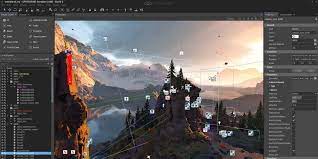Introduction:
Game engines are complex software systems that power modern video games. They provide a variety of tools and resources for game developers to create games more efficiently. Game engine architecture refers to the overall design and structure of a game engine. In this article, we will take a deep dive into game engine architecture and explore the different components that make up a game engine.
Components of a Game Engine
A typical game engine consists of several components, each responsible for a specific set of functionalities. The following are some of the most common components of a game engine:
Rendering System: The rendering system is responsible for displaying the graphics of the game. It includes a variety of tools and resources for creating 2D and 3D graphics, such as shaders, models, textures, and lighting systems.
Physics System: The physics system is responsible for simulating the physical behavior of the game world. It includes tools for creating rigid bodies, joints, and collision detection.
Audio System: The audio system is responsible for playing sound effects and music in the game. It includes tools for creating and managing audio assets, such as music tracks, sound effects, and voiceovers.
Input System: The input system is responsible for managing user input from keyboards, mice, and game controllers. It includes tools for configuring input devices, detecting user input, and mapping user input to game actions.
Networking System: The networking system is responsible for managing multiplayer games. It includes tools for connecting players, managing game sessions, and synchronizing game states between players.
Design Patterns in Game Engine Architecture
Design patterns are common solutions to recurring problems in software design. There are several design patterns that are commonly used in game engine architecture, such as the Entity-Component-System (ECS) pattern, the Observer pattern, and the Command pattern.
The ECS pattern is a data-driven approach to game development that separates game objects into entities and components. Each entity represents an object in the game world, while each component represents a specific attribute of that object, such as its position, velocity, or health. The ECS pattern makes it easier to manage complex game objects and enables more efficient processing of game data.
The Observer pattern is used to manage events and notifications in the game engine. It allows game objects to subscribe to events and receive notifications when those events occur. This pattern is commonly used for managing user input, game state changes, and other game events.
The Command pattern is used to encapsulate game actions into objects that can be executed, undone, and stored for later use. This pattern is commonly used for managing game input, such as keyboard and mouse commands.
Conclusion:
Game engine architecture is a complex topic that requires a deep understanding of software design and development. A typical game engine consists of several components, each responsible for a specific set of functionalities, such as rendering, physics, audio, input, and networking. Design patterns, such as the Entity-Component-System pattern, the Observer pattern, and the Command pattern, are commonly used in game engine architecture to manage game data, events, and actions.
Game engine architecture is an essential aspect of game development that can significantly affect the quality and performance of a video game. By understanding the different components of a game engine and the design patterns commonly used in game engine architecture, game developers can create more efficient and scalable game engines that enable them to create better video games.


No comments yet